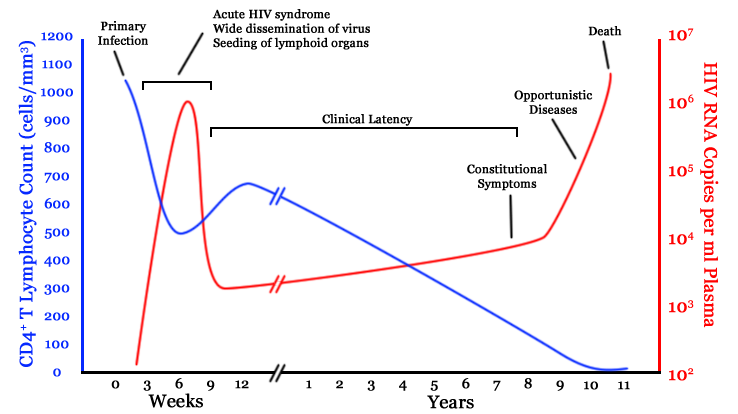A few months ago, I gave you a short primer on the immunology of vaccines. It’s time now for another short, oversimplified primer, this time on the immunology of HIV. This was originally up on the old blog, but it will provide some necessary background for upcoming posts (I think).
HIV denialists form a persistent little cult, and one of their newest leaders is Gary Null. Despite their small size and dearth of academic heavy-weights, they are quite loud, and can affect health policy.
Let’s delve into the immunology, and, once again, please forgive the over-simplification.
HIV—nasty non-critter
HIV is a retrovirus. Like all viruses, it is not a living organism as such, but a hunk of nucleic acids (in this case, RNA) and proteins that requires a living cell in order to reproduce. Take it away from a human body, and it rapidly becomes a useless hunk of chemicals.
HIV is a particularly successful virus for a variety of reasons. It has a very long latency period — that is, a person can be infected for years without symptoms, giving ample opportunity to spread the virus. It also reproduces quickly and in vast numbers, allowing for many random mutations which help it evade both the immune system and medications. While the mutations are random, the results are not. Introduce a selective pressure, such as a new anti-retroviral drug, and resistant variants will reproduce more successfully than non-resistant ones (it’s called “evolution”—deal with it). But all that happens after a person becomes infected. Let’s go back a step.
HIV—opening act
After entering a persons body, via sexual contact, dirty needles, and occasionally other blood and body fluid exposures (although those are the big ones), the virus is eaten up by local immune cells (macrophages) like any other virus. This leads to the viral parts being displayed on the outside of the cell for all to see, and T-cells come by to start the body’s specific immune response (you may want to reference my earlier article). Most viruses have a preference for one or another type of cell. Unfortunately for us, in the case of HIV, its preference is immune cells, especially a type of T-cell (CD4+ T-helper cells). Still, the body mounts a vigorous immune response (with flu-like symptoms), and despite an early and rapid spread of the virus to all parts of the body, the virus count in the blood rapidly drops. For now.
HIV–interregnum
 So your immune system did a nice job. It got the virus out of your blood. Unfortunately, the virus is very comfortable in the immune cells of the lymph nodes, and hangs out there, slowly reproducing. At that point, there is some mild depression of the immune system, with perhaps some additional risk of pneumonia and other diseases, but really, there isn’t much in the way of outward signs of disease. Your immune system, however, is being devastated. T-cells are serving as little HIV factories, but these factories burn down after a successful run. Your T-cell count is slowly dropping. After about ten years feeling generally OK, but then…
So your immune system did a nice job. It got the virus out of your blood. Unfortunately, the virus is very comfortable in the immune cells of the lymph nodes, and hangs out there, slowly reproducing. At that point, there is some mild depression of the immune system, with perhaps some additional risk of pneumonia and other diseases, but really, there isn’t much in the way of outward signs of disease. Your immune system, however, is being devastated. T-cells are serving as little HIV factories, but these factories burn down after a successful run. Your T-cell count is slowly dropping. After about ten years feeling generally OK, but then…
AIDS
As the years pass, the number of T-cells has steadily dropped. The ability of the body to discover new invaders, control old invaders, and activate a strong immune response has been decimated. Pneumocystis, an organism that normally lives peacefully in the lungs, no longer has T-cells to hold down its numbers. The same goes for TB. These diseases can quickly overwhelm someone with HIV.
Cancers that are rare in healthy people take advantage of decreased immunity. Lymphoma of the brain, which is caused by a viral infection, can pop up. So can Kaposi’s sarcoma, a rare cancer of the blood vessels, also caused by a virus.
Without treatment, AIDS is fatal in a matter of months.
I can haz gud nuz?
The study of HIV spurred a generation of research in the biomedical fields. Anti-HIV drugs became available about five or six years after the identification of the epidemic. Unfortunately, resistance to these drugs developed quickly, via the evolutionary mechanisms described above. Research showed that the virus had to be fought on multiple fronts at once to reduce resistance.
I was a medical student when one class of drugs, the protease inhibitors, came out. We went from full inpatient AIDS wards, to empty beds in a matter of months. HIV became a disease treated in the office. I now take care of elderly HIV patients—not for their HIV, but for the usual diseases that affect older adults, and for some of the side-effects of HIV meds, such has high cholesterol.
HIV is a great example of how science can actually work to produce good results. Of course, we have a long way to go in prevention and treatment, especially in developing countries. A vaccine is also a long way off.
If the HIV denialists have their way, you won’t have to worry about any advances in treatment of HIV, since they don’t believe it causes AIDS. Their foolishness is one of our greatest enemies, and must be battled daily.
Leave a Reply